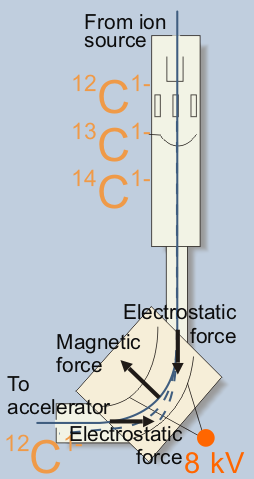To count sufficient number of 14C atoms in reasonable time, AMS spectrometer produces high currents of carbon ions. These ions, when passing through, discharge accelerator terminal at a rate which cannot be counterbalanced by practical systems of accelerator charging.To allow maintenance of constant accelerator voltage, a system of ion injection is used.


Injection magnet bends trajectories of ions, so only ions of certain mass are directed into accelerator. Usually it is set to inject only ions of atomic mass 14. The injection additionally prevents residual elements and compounds (which are present even in high-vacuum chambers) from interfering the 14C signal.
In radiocarbon dating, one must know 14C/12C and 14C/13C ratios, and one must measure currents of 12C and 13C, too. Therefore injection system is sequentially switched to inject lighter carbon atoms. Duration of 13C and 12C injection must be short – to avoid significant discharge of accelerator terminal.
Beam sequencer periodically switches ion masses injected into accelerator. This is performed by applying variable positive voltage to the magnet vacuum chamber. This produces electrostatic force which gives additional energy to the ions passing through the magnet, In effect, the higher voltage is applied, the lighter atoms can be directed (by constant magnetic force) towards the accelerator.
Sequential switching is very fast. In one cycle, 12C, 13C and 14C ions are injected during 0.1, 10 and 90 milliseconds, respectively.
Animation below: illustration of the beam sequencer operation.

Other pages on the AMS spectrometer:
General | Ion source | Injection magnet | Accelerator | Analysing magnet | Drift tube | Electrostatic analyser | 14C detector
